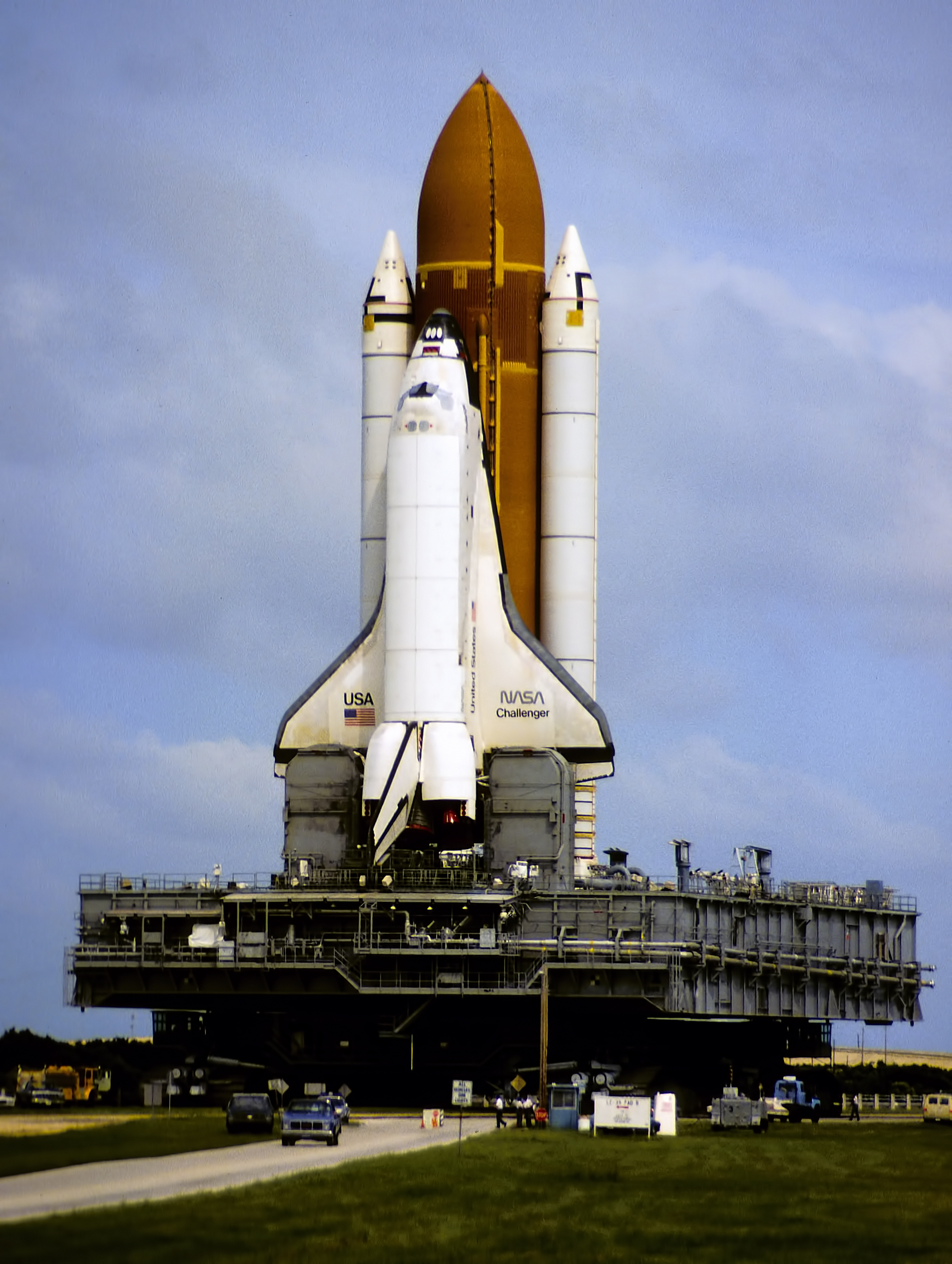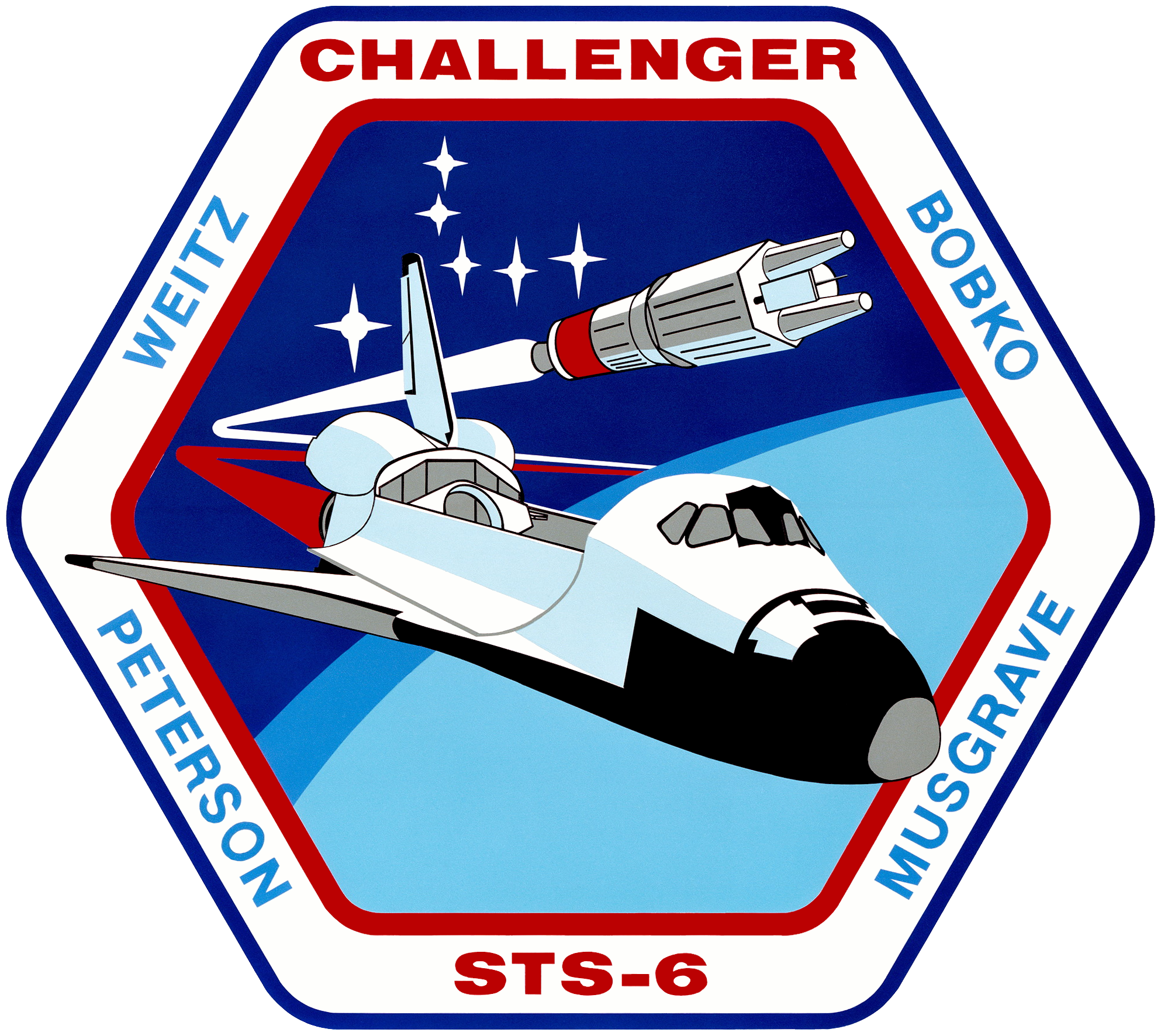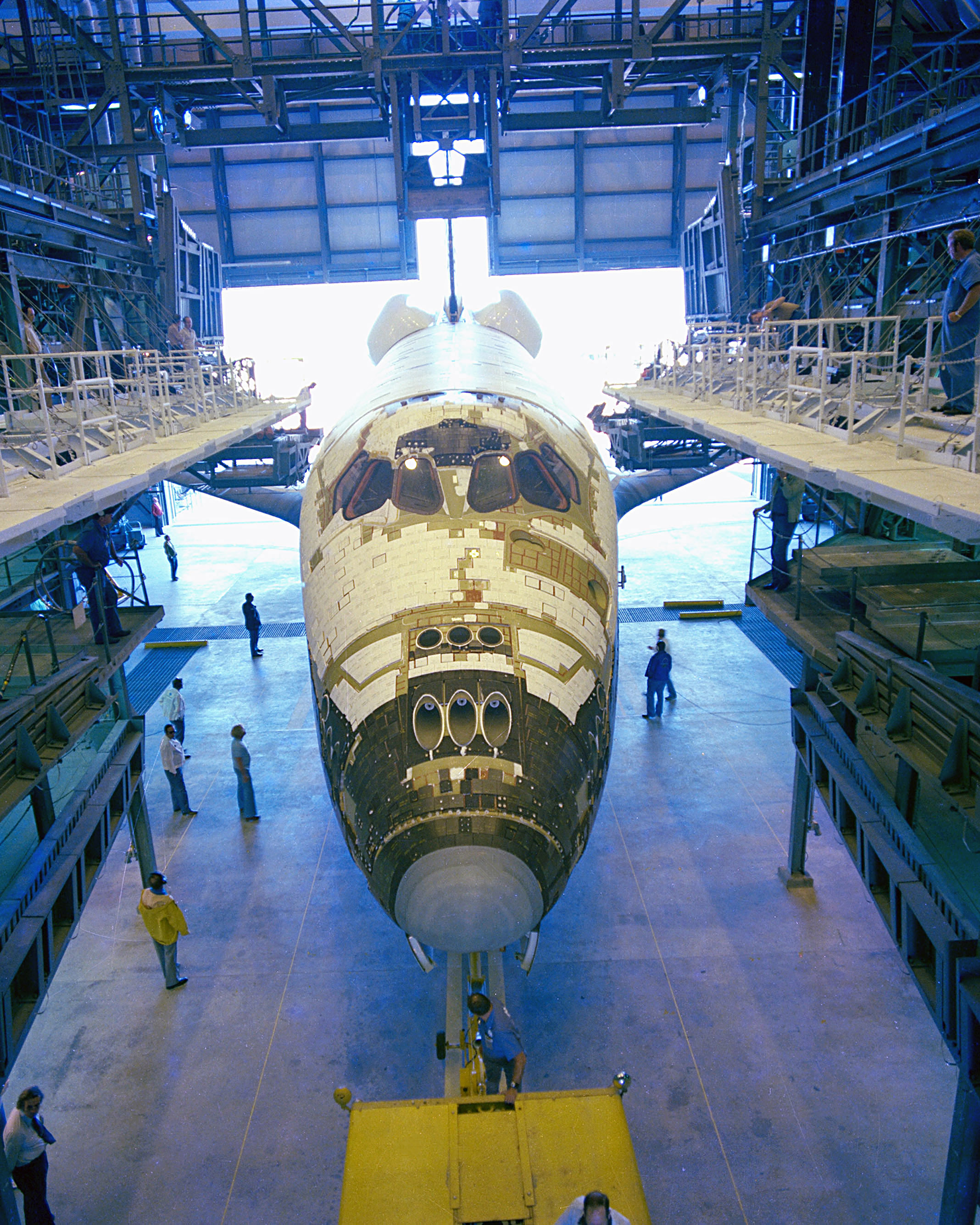|
STS-6
STS-6 was the sixth NASA Space Shuttle mission and the maiden flight of the . Launched from Kennedy Space Center on April 4, 1983, the mission deployed the first Tracking and Data Relay Satellite, TDRS-1, into orbit, before landing at Edwards Air Force Base on April 9, 1983. STS-6 was the first Space Shuttle mission during which a spacewalk was conducted, and hence was the first in which the Extravehicular Mobility Unit (EMU) was used. Crew STS-6 was the last shuttle mission with a four-person crew until STS-135, the final shuttle mission, which launched on July 8, 2011. Commander Paul Weitz had previously served as Pilot on the first Skylab crewed mission (Skylab-2), where he lived and worked in Skylab for nearly a month from May to June 1973. After Skylab, Weitz became the Deputy Chief of the Astronaut Office under Chief Astronaut John Young. Bobko originally became an astronaut for the Air Force's Manned Orbiting Laboratory (MOL) program but later joined NASA in 1 ... [...More Info...] [...Related Items...] OR: [Wikipedia] [Google] [Baidu] |
Space Shuttle Challenger
Space Shuttle ''Challenger'' (OV-099) was a Space Shuttle orbiter manufactured by Rockwell International and operated by NASA. Named after the commanding ship of a nineteenth-century scientific expedition that traveled the world, ''Challenger'' was the second Space Shuttle orbiter to fly into space after ''Columbia'', and launched on its maiden flight in April 1983. It was destroyed in January 1986 soon after launch in an accident that killed all seven crewmembers aboard. Initially manufactured as a test article not intended for spaceflight, it was utilized for ground testing of the Space Shuttle orbiter's structural design. However, after NASA found that their original plan to upgrade '' Enterprise'' for spaceflight would be more expensive than upgrading ''Challenger'', the orbiter was pressed into operational service in the Space Shuttle program. Lessons learned from the first orbital flights of ''Columbia'' led to ''Challenger''s design possessing fewer thermal prote ... [...More Info...] [...Related Items...] OR: [Wikipedia] [Google] [Baidu] |
Story Musgrave
Franklin Story Musgrave (born August 19, 1935) is an American physician and a retired NASA astronaut. He is a public speaker and consultant to both Disney's Imagineering group and Applied Minds in California. In 1996, he became only the second astronaut to fly on six spaceflights, and he is the most formally educated astronaut with six academic degrees. Musgrave is the only astronaut to have flown aboard all five Space Shuttles. Early life Musgrave was born August 19, 1935, the son of Percy Musgrave Jr. (1903–1973) and Marguerite Warton Musgrave (née Swann; 1909–1982). He grew up in Stockbridge, Massachusetts, but considers Lexington, Kentucky, to be his hometown. Musgrave has strong New England ancestral roots, descending from Mayflower Passengers John Howland and John Tilley, as well as early settler to Watertown, Massachusetts Richard Saltonstall. Saltonstall's uncle was Richard Saltonstall, Lord Mayor of London. His 4th great-grandfather was William Gray, a lieutena ... [...More Info...] [...Related Items...] OR: [Wikipedia] [Google] [Baidu] |
Space Shuttle
The Space Shuttle is a retired, partially reusable low Earth orbital spacecraft system operated from 1981 to 2011 by the U.S. National Aeronautics and Space Administration (NASA) as part of the Space Shuttle program. Its official program name was Space Transportation System (STS), taken from a 1969 plan for a system of reusable spacecraft where it was the only item funded for development. The first ( STS-1) of four orbital test flights occurred in 1981, leading to operational flights ( STS-5) beginning in 1982. Five complete Space Shuttle orbiter vehicles were built and flown on a total of 135 missions from 1981 to 2011. They launched from the Kennedy Space Center (KSC) in Florida. Operational missions launched numerous satellites, interplanetary probes, and the Hubble Space Telescope (HST), conducted science experiments in orbit, participated in the Shuttle-''Mir'' program with Russia, and participated in construction and servicing of the International Space Station (ISS ... [...More Info...] [...Related Items...] OR: [Wikipedia] [Google] [Baidu] |
TDRS-1
TDRS-1, known before launch as TDRS-A, was an American communications satellite, operated by NASA as part of the Tracking and Data Relay Satellite System. It was constructed by TRW and launched by on its maiden flight, STS-6. History While on the pad, problems were detected with ''Challenger'' main engines and repairs were begun. During this time, a severe storm caused contamination of TDRS-1 while it was in the Payload Change-out Room on the Rotating Service Structure at the launch pad. Consequently, the satellite had to be taken back to its checkout facility, where it was cleaned and rechecked. ''Challenger'' finally lifted off from Launch Complex 39A of the Kennedy Space Center at 18:30:00 UTC on 4 April 1983. Operations Following deployment from ''Challenger'', TDRS-1 was to be raised to its operational geosynchronous orbit by means of an Inertial Upper Stage, which consisted of two solid rocket motors, the first used to raise the orbit's apogee, the second its perigee. T ... [...More Info...] [...Related Items...] OR: [Wikipedia] [Google] [Baidu] |
Space Shuttle Program
The Space Shuttle program was the fourth human spaceflight program carried out by the U.S. National Aeronautics and Space Administration (NASA), which accomplished routine transportation for Earth-to-orbit crew and cargo from 1981 to 2011. Its official name, Space Transportation System (STS), was taken from a 1969 plan for a system of reusable spacecraft of which it was the only item funded for development. It flew 135 missions and carried 355 astronauts from 16 countries, many on multiple trips. The Space Shuttle—composed of an orbiter launched with two reusable solid rocket boosters and a disposable external fuel tank—carried up to eight astronauts and up to of payload into low Earth orbit (LEO). When its mission was complete, the orbiter would reenter the Earth's atmosphere and land like a glider at either the Kennedy Space Center or Edwards Air Force Base. The Shuttle is the only winged crewed spacecraft to have achieved orbit and landing, and the first r ... [...More Info...] [...Related Items...] OR: [Wikipedia] [Google] [Baidu] |
Extravehicular Mobility Unit
The Extravehicular Mobility Unit (EMU) is an independent anthropomorphic spacesuit that provides environmental protection, mobility, life support, and communications for astronauts performing extravehicular activity (EVA) in Earth orbit. Introduced in 1981, it is a two-piece semi-rigid suit, and is currently one of two types of EVA spacesuits used by crew members on the International Space Station (ISS), the other being the Russian Orlan space suit. It was used by NASA's Space Shuttle astronauts prior to the end of the Shuttle program in 2011. Suit components The EMU, like the Apollo/Skylab A7L spacesuit, was the result of 21 years of research and development. It consists of a Hard Upper Torso (HUT) assembly, a Primary Life Support System (PLSS) which incorporates the life support and electrical systems, arm sections, gloves, an Apollo-style "bubble" helmet, the Extravehicular Visor Assembly (EVVA), and a soft Lower Torso Assembly (LTA), incorporating the Body Seal Clo ... [...More Info...] [...Related Items...] OR: [Wikipedia] [Google] [Baidu] |
NASA Astronaut Group 6
NASA Astronaut Group 6 (the "XS-11", "Excess Eleven") was a group of eleven astronauts announced by NASA on August 11, 1967, the second group of scientist-astronauts. Although Director of Flight Crew Operations Deke Slayton planned to hire 20 to 30 new scientist-astronauts, he did not expect any to fly because of a surplus of astronauts amid the looming dearth of post- Apollo program funding, exemplified by the concomitant devolution of the Apollo Applications Program into the Skylab Program. NASA found that only 11 of the 923 applicants were qualified, and hired all. When the group reported to the Manned Spacecraft Center, Slayton told them that "We don't need you around here". He offered to accept their resignations, and promised ground assignments if they did not quit, but warned them to not fool themselves that they would soon fly in space. With self-deprecation, the men named themselves the "XS-11", or "Excess Eleven". The group would be the last group selected by NASA for ... [...More Info...] [...Related Items...] OR: [Wikipedia] [Google] [Baidu] |
Manned Orbiting Laboratory
The Manned Orbiting Laboratory (MOL) was part of the United States Air Force (USAF) human spaceflight program in the 1960s. The project was developed from early USAF concepts of crewed space stations as reconnaissance satellites, and was a successor to the canceled Boeing X-20 Dyna-Soar military reconnaissance space plane. Plans for the MOL evolved into a single-use laboratory, for which crews would be launched on 30-day missions, and return to Earth using a Gemini B spacecraft derived from NASA's Gemini spacecraft and launched with the laboratory. The MOL program was announced to the public on 10 December 1963 as an inhabited platform to demonstrate the utility of putting people in space for military missions; its reconnaissance satellite mission was a secret black project. Seventeen astronauts were selected for the program, including Major Robert H. Lawrence Jr., the first African-American astronaut. The prime contractor for the spacecraft was McDonnell Aircraft Corporatio ... [...More Info...] [...Related Items...] OR: [Wikipedia] [Google] [Baidu] |
STS-135
STS-135 (ISS assembly flight ULF7) was the 135th and final mission of the American Space Shuttle program. It used the orbiter '' Atlantis'' and hardware originally processed for the STS-335 contingency mission, which was not flown. STS-135 launched on 8 July 2011, and landed on 21 July 2011, following a one-day mission extension. The four-person crew was the smallest of any shuttle mission since STS-6 in April 1983. The mission's primary cargo was the Multi-Purpose Logistics Module (MPLM) '' Raffaello'' and a Lightweight Multi-Purpose Carrier (LMC), which were delivered to the International Space Station (ISS). The flight of ''Raffaello'' marked the only time that ''Atlantis'' carried an MPLM. Although the mission was authorized, it initially had no appropriation in the NASA budget, raising questions about whether the mission would fly. On 20 January 2011, program managers changed STS-335 to STS-135 on the flight manifest. This allowed for training and other mission specifi ... [...More Info...] [...Related Items...] OR: [Wikipedia] [Google] [Baidu] |
Kennedy Space Center
The John F. Kennedy Space Center (KSC, originally known as the NASA Launch Operations Center), located on Merritt Island, Florida, is one of the National Aeronautics and Space Administration's (NASA) ten field centers. Since December 1968, KSC has been NASA's primary launch center of human spaceflight. Launch operations for the Apollo, Skylab and Space Shuttle programs were carried out from Kennedy Space Center Launch Complex 39 and managed by KSC. Located on the east coast of Florida, KSC is adjacent to Cape Canaveral Space Force Station (CCSFS). The management of the two entities work very closely together, share resources and operate facilities on each other's property. Though the first Apollo flights and all Project Mercury and Project Gemini flights took off from the then-Cape Canaveral Air Force Station, the launches were managed by KSC and its previous organization, the Launch Operations Directorate. Starting with the fourth Gemini mission, the NASA launch con ... [...More Info...] [...Related Items...] OR: [Wikipedia] [Google] [Baidu] |
John Young (astronaut)
John Watts Young (September 24, 1930 – January 5, 2018) was an American astronaut, naval officer and aviator, test pilot, and aeronautical engineer. He became the ninth person to walk on the Moon as commander of the Apollo 16 mission in 1972. He is the only astronaut to fly on four different classes of spacecraft: Gemini, the Apollo command and service module, the Apollo Lunar Module and the Space Shuttle. Before becoming an astronaut, Young received his Bachelor of Science degree in Aeronautical Engineering from the Georgia Institute of Technology and joined the U.S. Navy. After serving at sea during the Korean War he became a naval aviator and graduated from the U.S. Naval Test Pilot School. As a test pilot, he set several world time-to-climb records. Young retired from the Navy in 1976 with the rank of captain. In 1962, Young was selected as a member of NASA Astronaut Group 2. He flew on the first crewed Gemini mission ( Gemini 3) in 1965, and then commanded ... [...More Info...] [...Related Items...] OR: [Wikipedia] [Google] [Baidu] |
Extravehicular Activity
Extravehicular activity (EVA) is any activity done by an astronaut in outer space outside a spacecraft. In the absence of a breathable atmosphere of Earth, Earthlike atmosphere, the astronaut is completely reliant on a space suit for environmental support. EVA includes ''spacewalks'' and Moon, lunar or planetary surface exploration (commonly known from 1969 to 1972 as ''moonwalks''). In a stand-up EVA (SEVA), an astronaut stands through an open hatch but does not fully leave the spacecraft. EVA has been conducted by the Soviet Union/Russia, the United States, Canada, the European Space Agency and China. On March 18, 1965, Alexei Leonov became the first human to perform a spacewalk, exiting the Voskhod 2 capsule for 12 minutes and 9 seconds. On July 20, 1969, Neil Armstrong became the first human to perform a moonwalk, outside his lunar lander on Apollo 11 for 2 hours and 31 minutes. On the last three Moon missions, astronauts also performed deep-space EVAs on the return to Eart ... [...More Info...] [...Related Items...] OR: [Wikipedia] [Google] [Baidu] |






.jpg)



